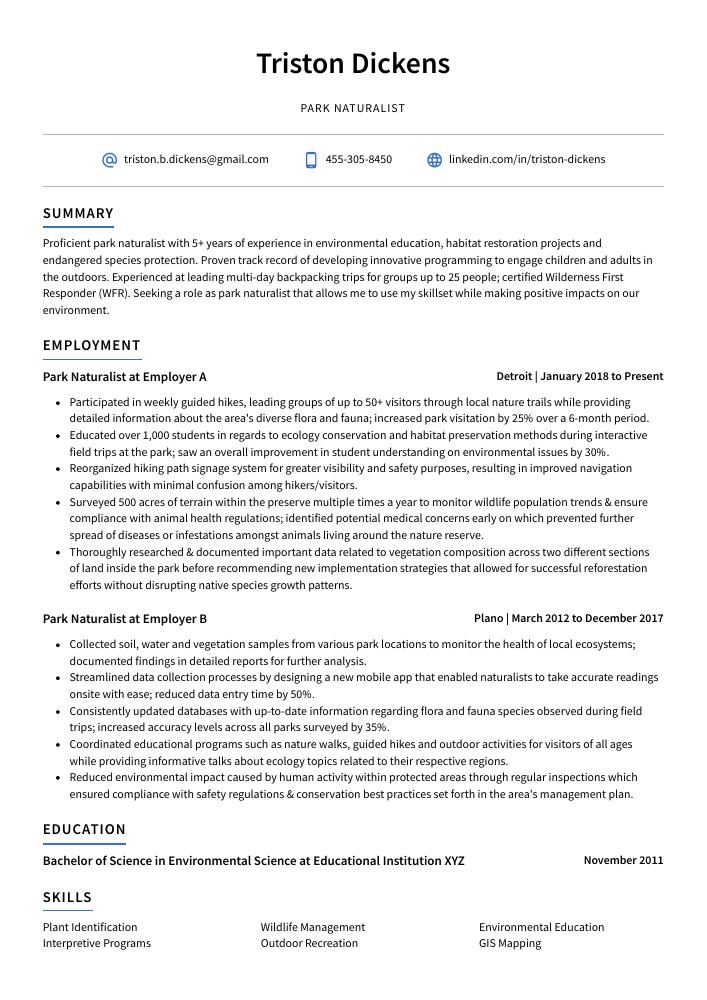Park Naturalist Resume Guide
Park Naturalists are responsible for managing, protecting and interpreting natural resources within parks. They monitor the health of ecosystems in their area, conduct research on local flora and fauna, lead educational programs to inform visitors about conservation practices, maintain trails and other recreation areas, as well as manage wildlife populations.
You have a passion for nature and wildlife, and it shows in your work. But park directors don’t know who you are yet. To make yourself known to them, you must craft an eye-catching resume that highlights your experience and qualifications.
This guide will walk you through the entire process of creating a top-notch resume. We first show you a complete example and then break down what each resume section should look like.
Table of Contents
The guide is divided into sections for your convenience. You can read it from beginning to end or use the table of contents below to jump to a specific part.
Park Naturalist Resume Sample
Triston Dickens
Park Naturalist
[email protected]
455-305-8450
linkedin.com/in/triston-dickens
Summary
Proficient park naturalist with 5+ years of experience in environmental education, habitat restoration projects and endangered species protection. Proven track record of developing innovative programming to engage children and adults in the outdoors. Experienced at leading multi-day backpacking trips for groups up to 25 people; certified Wilderness First Responder (WFR). Seeking a role as park naturalist that allows me to use my skillset while making positive impacts on our environment.
Experience
Park Naturalist, Employer A
Detroit, Jan 2018 – Present
- Participated in weekly guided hikes, leading groups of up to 50+ visitors through local nature trails while providing detailed information about the area’s diverse flora and fauna; increased park visitation by 25% over a 6-month period.
- Educated over 1,000 students in regards to ecology conservation and habitat preservation methods during interactive field trips at the park; saw an overall improvement in student understanding on environmental issues by 30%.
- Reorganized hiking path signage system for greater visibility and safety purposes, resulting in improved navigation capabilities with minimal confusion among hikers/visitors.
- Surveyed 500 acres of terrain within the preserve multiple times a year to monitor wildlife population trends & ensure compliance with animal health regulations; identified potential medical concerns early on which prevented further spread of diseases or infestations amongst animals living around the nature reserve.
- Thoroughly researched & documented important data related to vegetation composition across two different sections of land inside the park before recommending new implementation strategies that allowed for successful reforestation efforts without disrupting native species growth patterns.
Park Naturalist, Employer B
Plano, Mar 2012 – Dec 2017
- Collected soil, water and vegetation samples from various park locations to monitor the health of local ecosystems; documented findings in detailed reports for further analysis.
- Streamlined data collection processes by designing a new mobile app that enabled naturalists to take accurate readings onsite with ease; reduced data entry time by 50%.
- Consistently updated databases with up-to-date information regarding flora and fauna species observed during field trips; increased accuracy levels across all parks surveyed by 35%.
- Coordinated educational programs such as nature walks, guided hikes and outdoor activities for visitors of all ages while providing informative talks about ecology topics related to their respective regions.
- Reduced environmental impact caused by human activity within protected areas through regular inspections which ensured compliance with safety regulations & conservation best practices set forth in the area’s management plan.
Skills
- Plant Identification
- Wildlife Management
- Environmental Education
- Interpretive Programs
- Outdoor Recreation
- GIS Mapping
- Conservation Biology
- Ecological Restoration
- Natural Resource Management
Education
Bachelor of Science in Environmental Science
Educational Institution XYZ
Nov 2011
Certifications
Certified Interpretive Guide
National Association for Interpretation
May 2017
1. Summary / Objective
The summary/objective at the start of your park naturalist resume should be a snapshot of what you bring to the table. This is where you can highlight your best qualities, such as your knowledge and experience in wildlife conservation, leadership skills gained from leading outdoor activities for visitors, and ability to work with diverse groups of people. Showcase how these attributes make you an ideal candidate for this role.
Below are some resume summary examples:
Well-rounded park naturalist with 10+ years of experience in environmental education and conservation. Passionate about educating people on the importance of preserving natural habitats, committed to building a resilient relationship between humans and their local environment. Seeking an opportunity at ABC Park where I can use my knowledge and enthusiasm to engage visitors in outdoor activities that will foster a deeper connection with nature.
Dependable park naturalist with 5+ years of experience studying, researching and educating about the local environment. Committed to preserving nature for future generations. At XYZ Park, improved environmental awareness among staff and visitors by designing innovative educational programs. Recognized as a leader in promoting conservation initiatives through community outreach activities such as fundraising events and public talks.
Enthusiastic park naturalist with 5+ years of experience in environmental education and the preservation of wildlife habitats. Dedicated to promoting conservation initiatives while inspiring others to respect nature. Proven success leading educational activities for groups up to 25 people, resulting in an increase of 15% park visitors over a three-year period. Looking forward to joining ABC Park as a Naturalist Educator.
Reliable park naturalist with 7+ years of experience leading educational programs, organizing field trips and providing nature hikes to the public. Adept at maintaining park facilities, creating wildlife education materials and implementing conservation efforts according to best practices. Seeking a position at ABC Park where I can utilize my expertise in ecology and bring meaningful changes to our local environment.
Committed park naturalist with 5+ years of experience in the outdoors. Passionate about educating visitors on local wildlife and flora, as well as preserving habitats for future generations to enjoy. At XYZ Park, increased visitor engagement by 25% through interactive activities and field trips that highlighted the importance of conservation. Recognized twice for outstanding workmanship with park clean-up campaigns.
Detail-oriented Park Naturalist with 5+ years of experience in leading outdoor education programs and conducting wildlife surveys. Skilled at developing interpretive materials, including lectures, activities, guided hikes, and lesson plans for all ages. Passionate about connecting people to nature through hands-on experiences; successfully developed a series of field trips that increased park visitation by 20%.
Energetic park naturalist with 5+ years of experience leading educational outdoor activities for visitors of all ages. Skilled in identifying and protecting native species, developing interpretive programs, and maintaining trails. Seeking to bring expertise in conservation biology to ABC Park where I can help educate guests about the importance of preserving our environment.
Driven Park Naturalist with 8+ years of experience leading guided tours and educating the public on local ecology. Expertise in developing interactive educational programs for children, adults, and families that bring conservation to life. Looking to join ABC Park as a lead naturalist where I can engage visitors while helping them appreciate their park more deeply.
2. Experience / Employment
In the experience section, you should list your employment history in reverse chronological order. This means the most recent job is listed first.
When writing this section out, stick to bullet points primarily; it makes it easier for the reader to digest what you have written quickly and efficiently. When stating what you did, be sure to provide detail on how your work resulted in tangible outcomes or accomplishments.
For example, instead of saying “Led educational hikes,” you could say “Conducted weekly guided nature walks for groups of up to 15 people that focused on teaching about local flora and fauna; increased attendance by 50% over a three-month period.”
To write effective bullet points, begin with a strong verb or adverb. Industry specific verbs to use are:
- Monitored
- Educated
- Interpreted
- Led
- Assessed
- Surveyed
- Collected
- Preserved
- Restored
- Protected
- Identified
- Managed
- Patrolled
- Investigated
- Documented
Other general verbs you can use are:
- Achieved
- Advised
- Compiled
- Coordinated
- Demonstrated
- Developed
- Expedited
- Facilitated
- Formulated
- Improved
- Introduced
- Mentored
- Optimized
- Participated
- Prepared
- Presented
- Reduced
- Reorganized
- Represented
- Revised
- Spearheaded
- Streamlined
- Structured
- Utilized
Below are some example bullet points:
- Achieved a 20% increase in park visitor engagement within a 2-month period through the implementation of innovative interpretive programs.
- Spearheaded new educational initiatives such as youth camps and guided hikes, increasing overall public awareness about local ecology by 25%.
- Proficiently operated various scientific equipment to analyze water samples for contaminants and successfully reported findings to environmental authorities on time.
- Revised existing conservation plans for two state parks, introducing more efficient strategies that reduced operational costs by 15%.
- Mentored four college interns in ecological research methods; provided oversight resulting in increased productivity during fieldwork activities by 50%.
- Accurately interpreted natural features and phenomena of local park ecosystems to over 400 visitors each month, increasing public awareness of the environment by 35%.
- Optimized the preservation efforts in a 500-acre wilderness area; implemented sustainable practices that reduced water usage by 25% while maintaining wildlife habitat quality.
- Demonstrated an extensive knowledge of plant & animal species native to the region, leading guided tours with up to 15 participants at any time.
- Presented educational programs on ecology and conservation topics for schools as well as community groups; developed new curricula based on current research findings which improved participant engagement levels by 20%.
- Developed interactive activities such as scavenger hunts and campfire stories tailored around seasonal events held at parks throughout the county, resulting in increased visitation rates from 5% – 7%.
- Improved the accessibility of outdoor spaces, leading guided hikes and nature walks for over 650 visitors, with a 97% satisfaction rate.
- Utilized knowledge of flora & fauna to identify over 40 species native to the park, educating visitors on their characteristics and habitats during interactive presentations.
- Identified potential hazards in the area by conducting regular inspections; reported all issues promptly to management for prompt resolution before any incidents occurred.
- Represented the park at numerous community events throughout the year such as Earth Day celebrations and wildlife awareness campaigns; raised $2,000 in donations from local businesses towards conservation efforts within 6 months of joining team.
- Actively contributed ideas towards developing new programs designed to enhance visitor experience such as birdwatching excursions or educational lectures about endangered animals; successfully launched 4 initiatives within 12 months resulting in 20+ additional participants each month.
- Facilitated educational programs and activities on the park’s diverse ecosystems for over 500 participants each year; reduced program costs by 10%.
- Investigated local plant and wildlife to identify any potential threats, prepared detailed reports of findings that included recommendations for habitat conservation efforts.
- Managed a team of 4 assistant naturalists in conducting guided tours around the park, identifying plants & animals, maintaining trails and providing information about various species; increased tour attendance by 15% within first 6 months.
- Documented seasonal changes in fauna populations through monitoring studies conducted at least twice per month; recorded data accurately with 90% accuracy rate or higher.
- Meticulously maintained records tracking visitors’ interactions with nature while observing safety regulations at all times to ensure safe experiences were had by all visitors to the park.
- Patrolled a 600 acre park on a daily basis, investigating and reporting any animal or plant-related issues to the supervisor.
- Effectively educated over 500 visitors each month about local flora & fauna; increased knowledge of endangered species by 30%.
- Monitored wildlife populations in the area and compiled detailed reports on population health, behavior patterns, habitat changes and other related data for submission to government authorities every quarter.
- Led guided nature walks through various trails within the park twice per week during peak season; gained an average rating of 4 stars out of 5 from participants due to enthusiasm and content delivery skills that exceeded expectations.
- Compiled relevant information such as maps, photographs and articles into educational materials used for lectures at schools throughout county; awarded Employee Of The Month recognition 3 times based on superior performance in this role.
- Developed and implemented educational programs covering various aspects of the local flora and fauna for more than 200 visitors each week, with an overall satisfaction rate of 94%.
- Assessed and monitored park wildlife population to ensure sustainability; identified potential risks in habitats caused by human activity and reduced their impact by 41%.
- Protected endangered species through weekly patrolling activities, leading to a 17% increase in the number of protected animals within one year.
- Efficiently managed organizational resources such as staff, tools & equipment onsite; improved operational efficiency by reducing costs associated with maintenance tasks by $1,200 monthly on average.
- Expedited data entry processes related to research projects that led to a 14% improvement in accuracy while handling large amounts of information at once. (optional).
- Formulated educational programming and interactive activities for over 50 school groups, families and visitors; increased park attendance by 20% in the last quarter.
- Prepared detailed reports on flora/fauna of the area including species identification, population estimates and habitat characteristics to preserve local biodiversity.
- Structured guided tours through nature trails to teach visitors about natural history, conservation efforts & environmental protection measures while ensuring their safety at all times.
- Preserved habitats with a team of volunteers by removing invasive plant species from native ecosystems; reduced debris accumulation along trails by 15%.
- Successfully implemented educational activities such as scavenger hunts, bird watching events & arts-n-crafts projects that engaged over 300 participants during peak season months.
- Introduced educational programs to over 100 local school groups on the native wildlife, plants and habitats of the park; raised environmental awareness by 15%.
- Restored 250 acres of natural habitat in the park through controlled burning and vegetation thinning activities, successfully doubling its biodiversity index.
- Advised community members on sustainable gardening practices such as water conservation techniques, wildflower planting & composting methods; reduced garden-related emissions by 30%.
- Competently monitored endangered species populations within a 300 square mile area using various tracking tools; identified 3 new bird nesting sites for protection purposes with successful outcomes.
3. Skills
Two organizations that have advertised for a position with the same title may be searching for individuals whose skills are quite different. For instance, one might be looking for someone with a background in environmental science and another may want an individual who is experienced in leading outdoor activities.
In order to make sure your resume stands out, you should tailor the skills section of your resume to each job that you are applying for. This will help ensure that applicant tracking systems (which many employers use) recognize the keywords they are searching for when scanning resumes.
It is also important to elaborate on these skills further by discussing them in more detail within other sections such as experience or summary.
Below is a list of common skills & terms:
- Conservation Biology
- Ecological Restoration
- Environmental Education
- GIS Mapping
- Interpretive Programs
- Natural Resource Management
- Outdoor Recreation
- Plant Identification
- Wildlife Management
4. Education
Including an education section on your resume will depend on how far along you are in your career. If you just graduated and have no work experience, mention your education below the resume objective. However, if you have been working as a park naturalist for years with plenty of different responsibilities to showcase, omitting the education section is perfectly fine.
If an educational background is included, try to list courses and subjects related to being a park naturalist that may be relevant to the job position applied for.
Bachelor of Science in Environmental Science
Educational Institution XYZ
Nov 2011
5. Certifications
Certifications are a great way to show potential employers that you have the necessary skills and knowledge for the job. It is important to include any certifications relevant to the position in your resume, as it will demonstrate your commitment and dedication towards professional development.
Certifications can also be used as evidence of meeting industry standards or demonstrating proficiency in certain areas such as software engineering, project management, data analysis etc., which could give you an edge over other applicants.
Certified Interpretive Guide
National Association for Interpretation
May 2017
6. Contact Info
Your name should be the first thing a reader sees when viewing your resume, so ensure its positioning is prominent. Your phone number should be written in the most commonly used format in your country/city/state, and your email address should be professional.
You can also choose to include a link to your LinkedIn profile, personal website, or other online platforms relevant to your industry.
Finally, name your resume file appropriately to help hiring managers; for Triston Dickens, this would be Triston-Dickens-resume.pdf or Triston-Dickens-resume.docx.
7. Cover Letter
Cover letters are an important part of the job application process as they provide recruiters with additional insights into who you are and why you’re applying for a particular role. Although cover letters aren’t always necessary, writing one can be beneficial in helping you stand out from other applicants.
A good cover letter should consist of 2 to 4 paragraphs that introduce yourself, explain your qualifications and highlight how well suited you are for the position. It’s also important to make sure it is tailored specifically to each company or job opportunity so that employers know that this isn’t just a generic document sent out multiple times.
Below is an example cover letter:
Dear Sheila,
I am writing to apply for the position of Park Naturalist at Yellowstone National Park. As a naturalist with more than 10 years of experience conducting educational programs and leading nature walks, I have the knowledge and skills necessary to excel in this role.
In my current position as a park ranger at Glacier National Park, I develop and lead interpretive programs about the park’s ecology and history for both children and adults. I also design environmental education curriculum for school groups, lead nature hikes, and give talks about Leave No Trace principles. In addition to my work as a ranger, I have also served as an AmeriCorps member, where I developed trail maintenance plans and conducted invasive species removal projects.
My experience has given me a deep understanding of both the natural world and the ways in which people interact with it. My passion for educating others about how to protect our environment makes me confident that I would be an excellent fit for your organization. In addition to my professional experience, I hold a Bachelor’s degree in Environmental Studies from UC Berkeley.
I believe that my skills and qualifications make me uniquely suited for this position, and I look forward to contributing to the important work of your organization. Thank you for your time; please do not hesitate to contact me if you have any questions or would like additional information about my background or qualifications.
Sincerely,
Triston
Park Naturalist Resume Templates
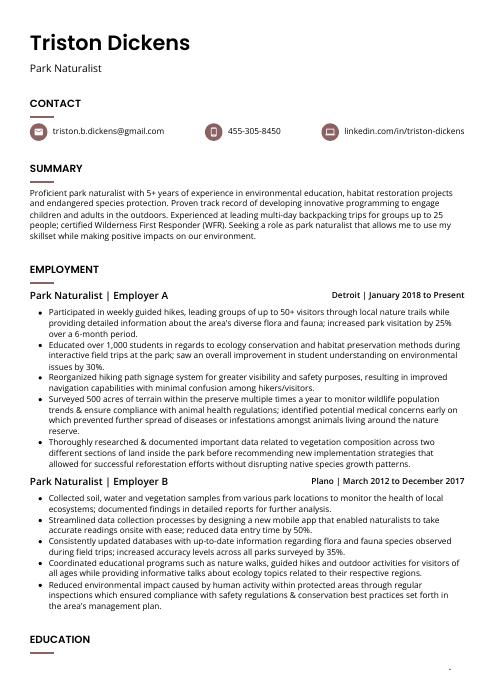 Fossa
Fossa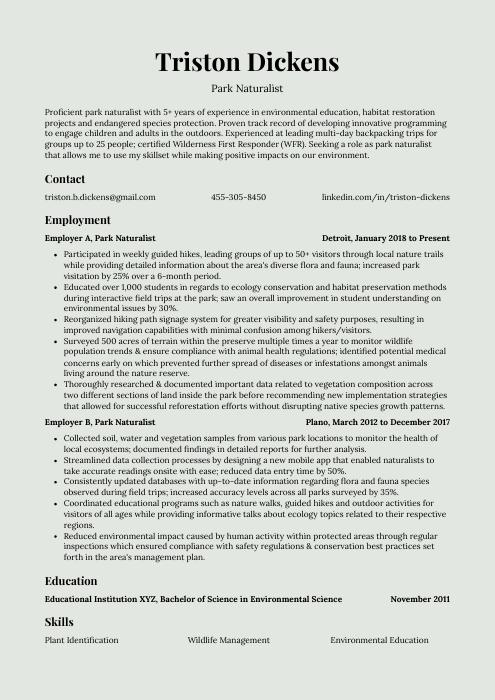 Saola
Saola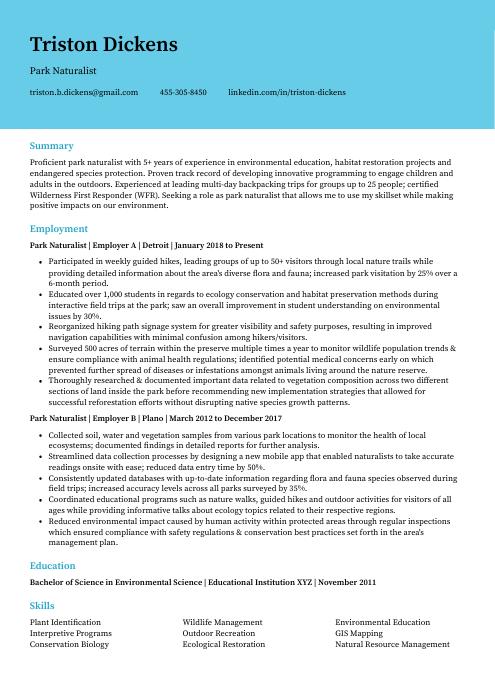 Dugong
Dugong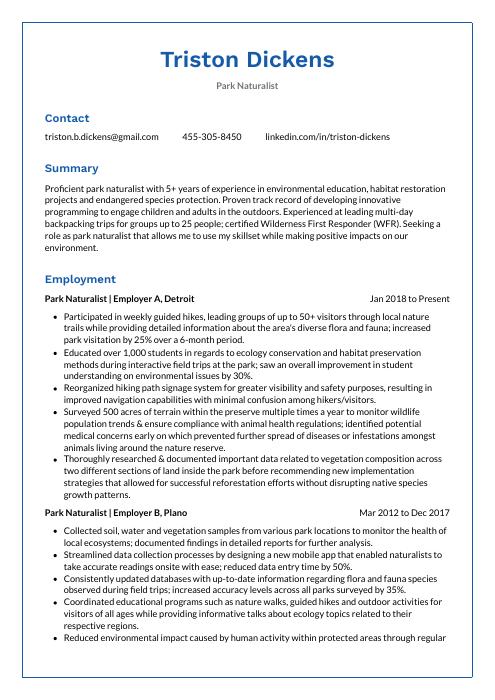 Markhor
Markhor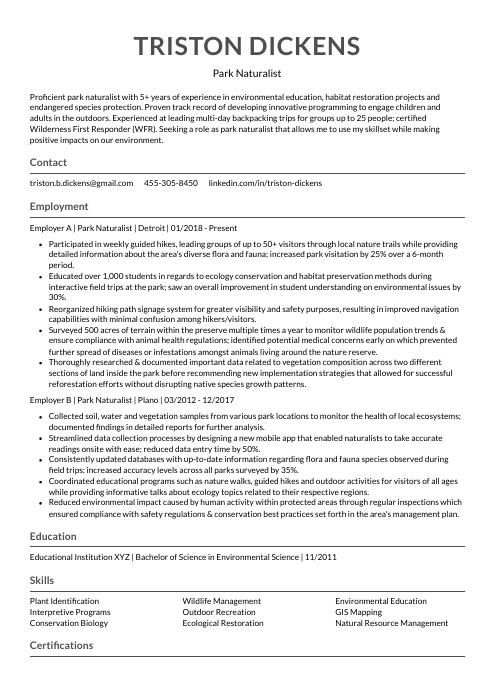 Indri
Indri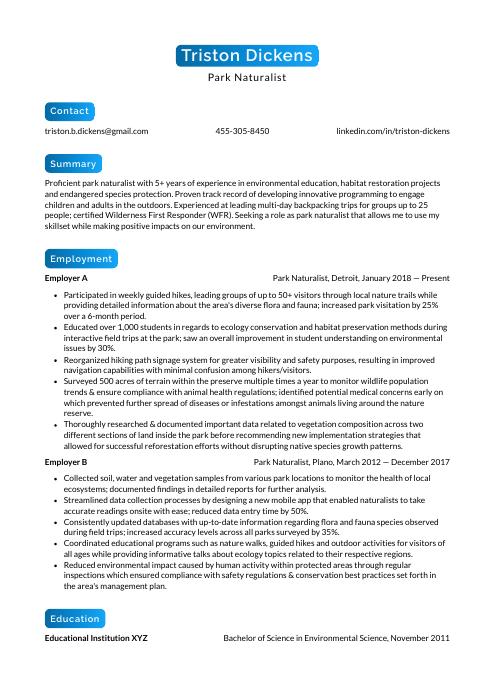 Kinkajou
Kinkajou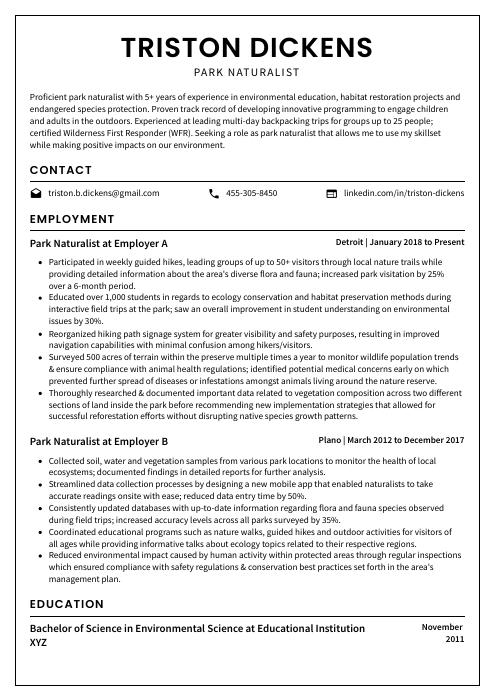 Cormorant
Cormorant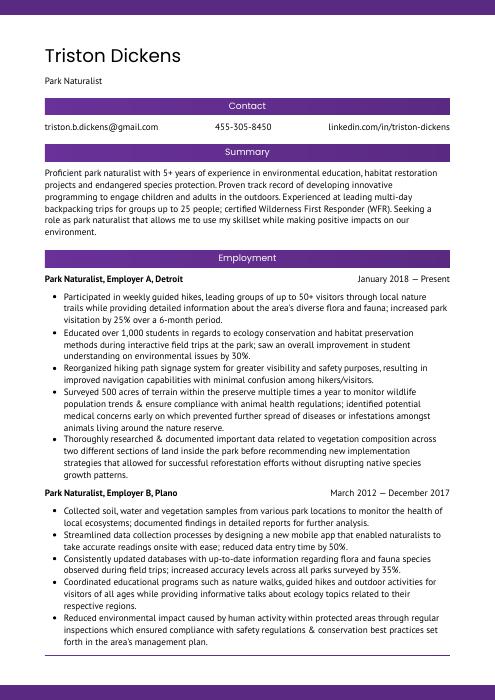 Jerboa
Jerboa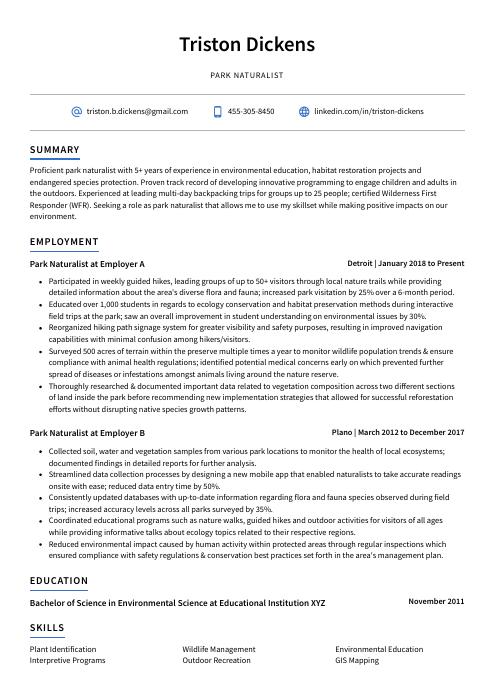 Axolotl
Axolotl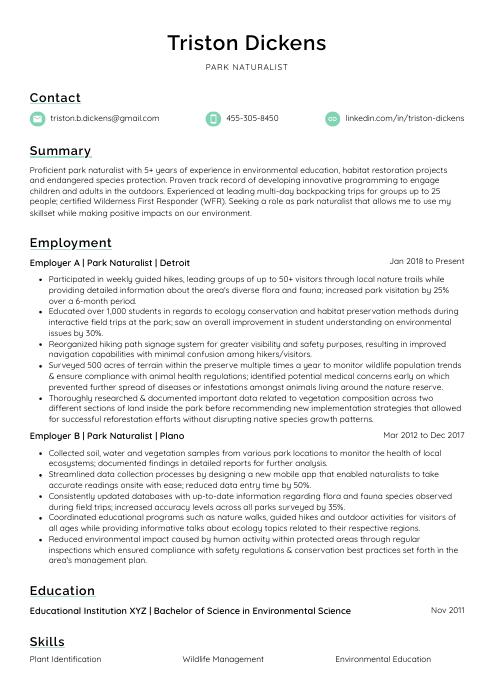 Lorikeet
Lorikeet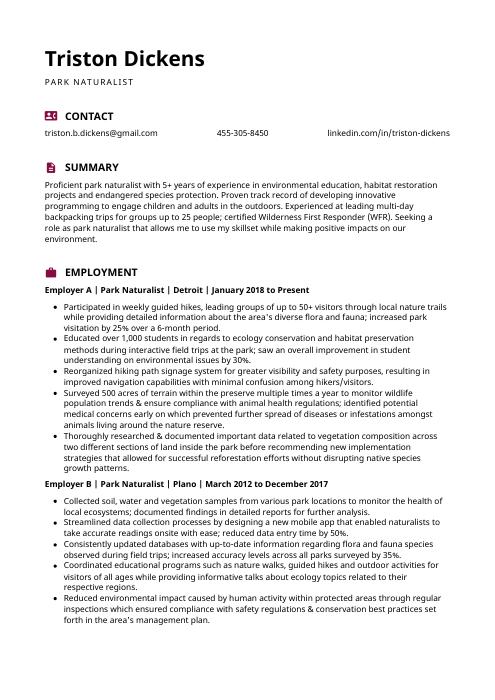 Hoopoe
Hoopoe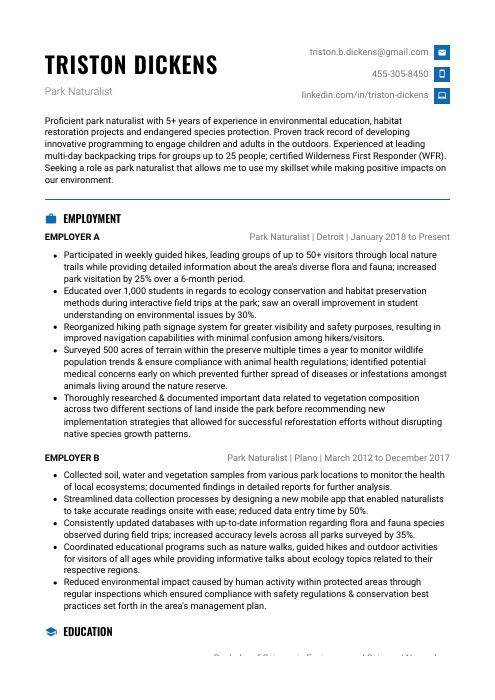 Echidna
Echidna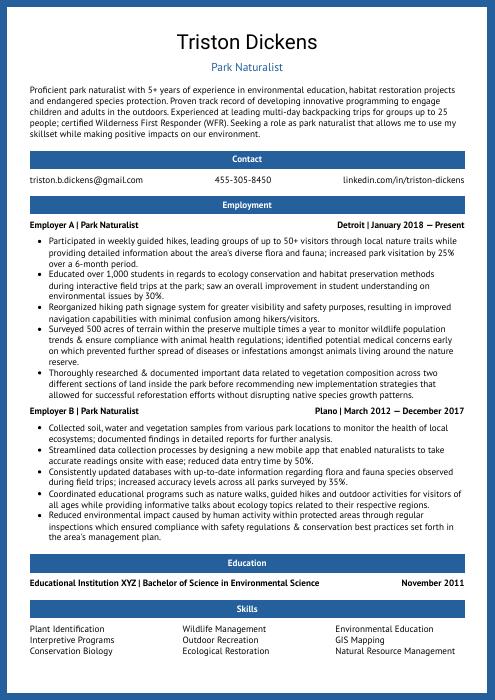 Ocelot
Ocelot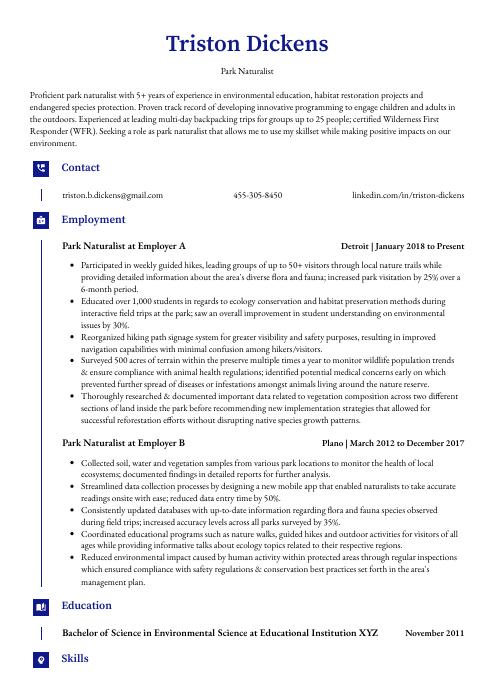 Gharial
Gharial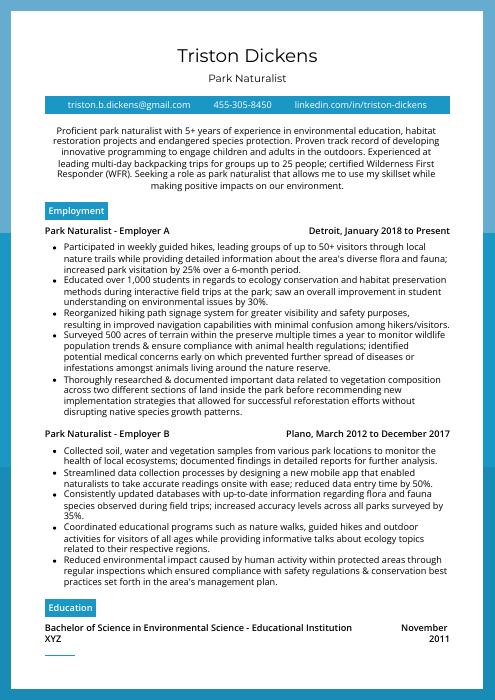 Rhea
Rhea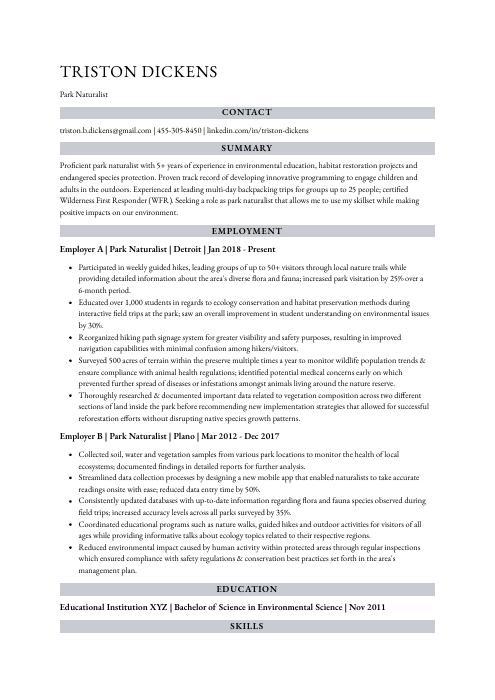 Numbat
Numbat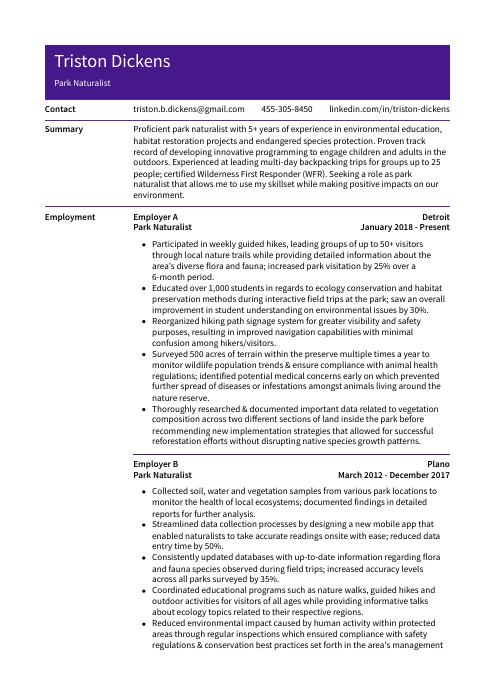 Pika
Pika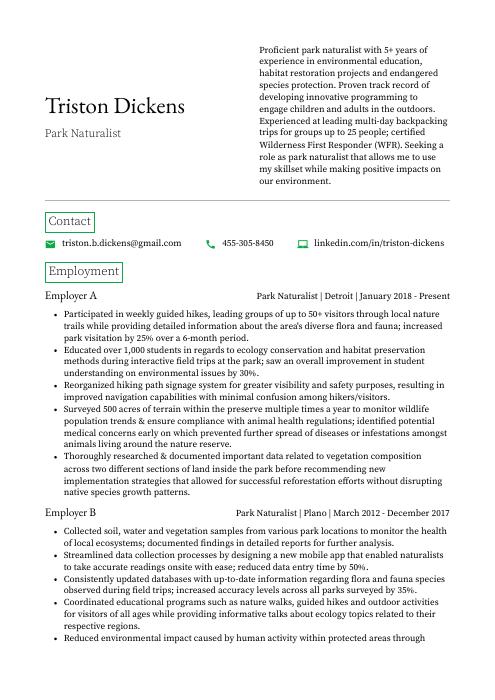 Quokka
Quokka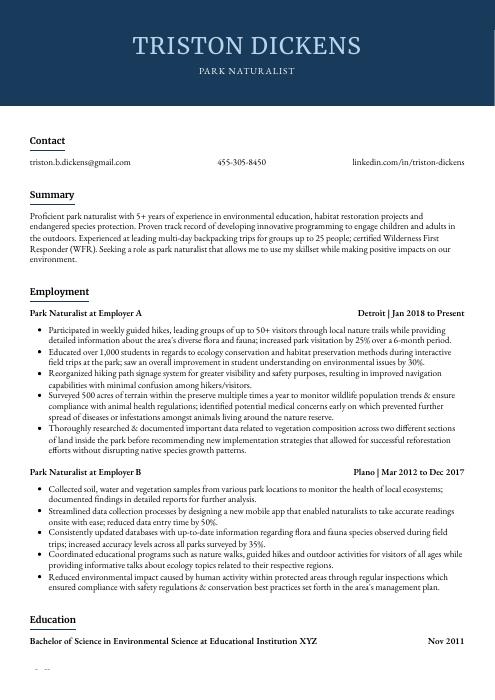 Bonobo
Bonobo Rezjumei
Rezjumei
